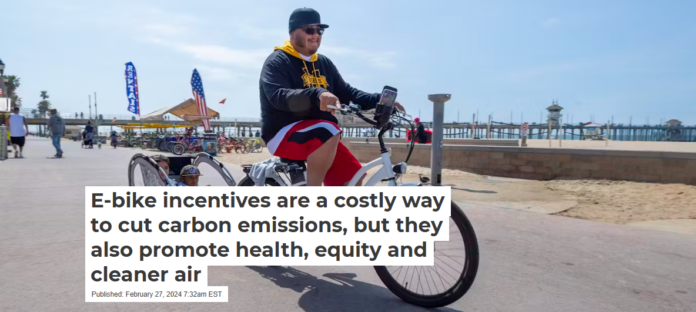

Christopher R. Cherry, University of Tennessee; John MacArthur, Portland State University, and Luke Jones, Valdosta State University
E-bikes have captured widespread attention across the U.S., and for good reason. They are the most energy-efficient way to move from place to place, providing exercise in the process, and offer enough assistance while pedaling uphill or into headwinds to make them usable for many types of riders.
Greenhouse gas emissions from e-bikes are much lower than those from either gasoline-powered or electric cars. Some cities and states are encouraging the use of e-bikes by providing purchase incentives, often drawing on public funds dedicated to curbing climate change.
Currently, over 100 cities and states have or plan to launch e-bike incentive programs, most funded by energy or environment initiatives. However, there has been little research on the effectiveness of these types of programs, how to design them or how to define goals.
We study transportation from many angles, including innovation, sustainability and economics. Our new study, published in the journal Transportation Research Part D, investigates the effectiveness of several types of e-bike purchase incentives and the investment required to induce additional e-bike purchases.
We found that incentives do spur extra e-bike purchases, but at a relatively high cost compared with narrowly defined climate benefits. We find that a public agency using a point-of-purchase discount would have to distribute about US$4,000 in incentives to generate one additional e-bike purchase. This is because over 80% of people who buy an e-bike would likely have bought one even without the discount. For perspective, it takes about $30,000 worth of incentives to induce an electric car purchase. https://www.youtube.com/embed/8cAJzqjNx0I?wmode=transparent&start=0 California initiated a $10 million statewide program in 2023 that offers voucher incentives to low-income residents for purchasing electric bikes.
Nonetheless, e-bikes provide many other benefits. They make mobility easier and more affordable for many people, including older adults and people with disabilities. They bolster the case for investing in bike paths and infrastructure, which produce economic, safety and mobility benefits for cities. And they boost health by promoting exercise. In our view, cities and states should assess e-bike incentive investments based on this broad range of benefits, rather than focusing solely on a narrow environmental objective.
Not just a climate tool
Clean technology incentives tend to be focused on a specific outcome – usually, reducing greenhouse gas emissions. This works well for most energy-related upgrades, such as replacing old air conditioners, improving home insulation and generating electricity from wind and solar power. Consumers want the services that these devices deliver – cool air, comfortable conditions indoors and electricity that’s available and affordable. The new devices simply deliver those familiar goods more sustainably.
E-bike incentives are different. They invite people to adopt a new technology that can fundamentally change recipients’ travel patterns. In fact, while replacing car trips with e-bike trips can provide substantial climate benefits, those benefits may be smaller than other benefits that are less widely measured. Focusing narrowly on reducing greenhouse gas emissions by replacing car trips means providing incentives to people who drive the most, or who drive the biggest gas guzzlers.
But what about carless households, transit riders or bicyclists? For them, e-bikes can make it much easier to travel in most North American cities. That increased mobility could provide greater access to jobs, shopping or other important services, such as health care.
Is investing in e-bike incentives worth it?
Transportation is the largest source of U.S. greenhouse gas emissions. Electrifying as much of it as possible is an important strategy for slowing climate change. However, e-bike incentives – and, indeed, electric car incentives – are pretty expensive ways to reduce emissions.
The importance of e-bike incentives is that e-bikes are good at replacing car trips and make daily trips easier for people who rely on other options. These advantages provide two main classes of benefits from increasing ownership of e-bikes.
The first set of benefits comes from substituting car-based trips with e-bike trips. Transportation researchers think about a swap like this in terms of vehicle miles traveled.
If I used to drive to work but now ride an e-bike, many benefits will be proportional to the number of miles that I now cover by bike rather than by car. They include reduced traffic congestion, lower fuel and parking costs, increased physical activity and improved health, cleaner air and reduced greenhouse gas emissions. In North America, about 60% of e-bike trips replace car trips.
A second class of benefits comes from improvements in mobility. These effects are more complex to measure. For many people in U.S. cities who don’t own cars, the basic options for getting around are walking, public transit, ride-hailing services like Uber and Lyft, or riding a conventional bicycle. In almost all cases, e-bikes would get them to their destinations faster. https://www.youtube.com/embed/rQhzEnWCgHA?wmode=transparent&start=0 A father explains how his family used electric cargo bikes to replace a car in Toronto and the Netherlands.
Carless households tend to have lower income and lack mobility options. E-bike incentives can make travel more affordable and give people better access to jobs, health care, child care, shopping and other destinations. Such benefits likely far exceed any nominal greenhouse gas accounting from these transportation users.
E-bike purchase incentives are an investment in the broad benefits that e-bikes can provide. We believe they should be measured against the collective goals of the agency providing the incentives, whether its mission is transportation, equitable mobility, public health, economic development or environmental protection.
Putting more people on two wheels
Once there’s agreement that e-bikes are worth supporting for many reasons, the challenge is how to induce more e-bike use and realize those benefits.
Point-of-purchase discounts or vouchers are the most popular strategy, because they mimic other clean energy incentives, such as those for high-efficiency appliances or electric cars. Our study found that they are also the most efficient way to influence consumer behavior compared with other purchase incentives, such as rebates.
Other strategies could be more effective but need further research. For example, e-bike lending libraries let people test-ride e-bikes without ownership. And employers can provide e-bikes to employees to help encourage more sustainable and affordable ways to get to work.
Partnering with community organizations or local mobility-oriented programs could be an effective way to get e-bikes into the hands of people who need them and couldn’t afford them otherwise. And giving e-bike owners more reason to use them, such as payments for biking to work, could increase e-bike use and subsequent benefits.
E-bike purchase incentives may be an expensive climate solution, but they also offer other important benefits. Carefully designed incentive programs could help many urban and suburban residents access a faster, healthier and cleaner way to get where they need to go.
Christopher R. Cherry, Professor of Civil and Environmental Engineering, University of Tennessee; John MacArthur, Sustainable Transportation Program Manager, Transportation Research and Education Center, Portland State University, and Luke Jones, Professor of Economics, Valdosta State University
This article is republished from The Conversation under a Creative Commons license. Read the original article.



















